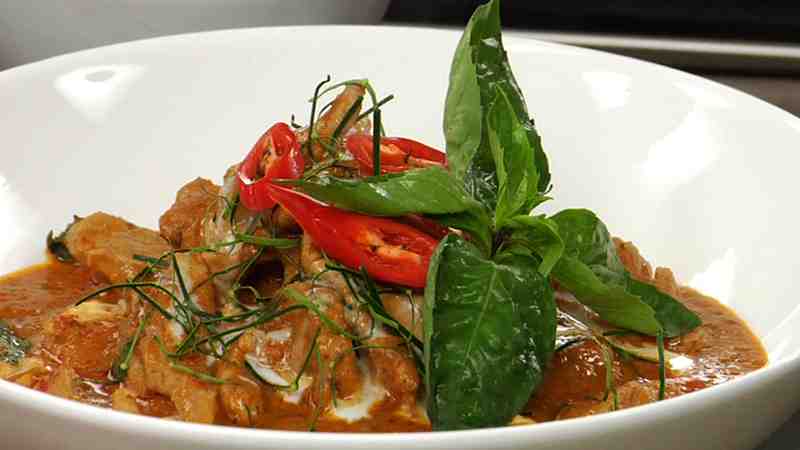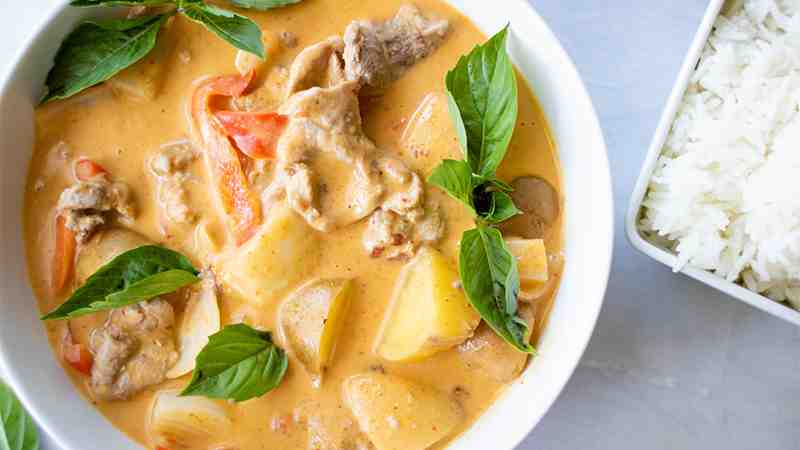This Pork Panang Curry Recipe has been our family favorite for years, and I am so excited to share this delicious dish with others.
The coconut milk and fish sauce flavor serve as the perfect canvas for spices, stir-frying, and seasoning to create a savory delight that is versatile and easy to make.
Best of all, it’s made in one pot! This dish pairs well with Thai iced tea or green tea as a refreshing drink accompaniment.
How to make Pork Panang Curry Recipe
Ingredients:
- 1 lb (450g) pork loin or leg, cut into cubes
- 2 tablespoons oil
- 2 tablespoons Thai green curry paste (น้ำหอยเขียวเพชร)
- 1 onion, chopped
- 10 oz (300g) broccoli florets, cut into matchsticks
- 1 can (14 oz / 400ml) coconut milk
- 2 teaspoons fish sauce.
Instructions:
Step 1: In a large pan, heat oil over medium-high heat. Add the pork and cook until browned. Add the Thai green curry paste and stir until fragrant.
Step 2: Add the broccoli florets and onions to the pan, cooking in batches if necessary to avoid overcrowding.
Step 3: Cook until the vegetables are soft and lightly browned on all sides, stirring occasionally. Reduce heat to low, add coconut milk and fish sauce, and remove from heat.
Step 4: Serve with steamed jasmine rice; enjoy!
Nutrition facts of Pork Panang Curry Recipe
- Calories: 420 kcal
- Fat: 8g
- Protein: 31g
- Carbohydrates: 56.5g
- Sugar: 6.5g
Health Benefits of Pork Panang Curry Recipe
This recipe contains pork and broccoli. It is a good source of Vitamins B6 and C, which are needed to keep your nervous system in good condition.

Vitamin B6 aids digestion, and Vitamin C contributes to maintaining healthy bones, teeth, nerves, muscles, and skin.
This recipe contains fish sauce (5% – 10%), providing you with essential Omega-3 fatty acids EPA & DHA that are very important in preventing heart disease, acting as anti-inflammatories, and positively affecting blood pressure.
Best 5 Variations for Pork Panang Curry Recipe
1. Mince 3-4 cloves and insert them into the large pan along with the pork before cooking. Let them simmer and release their aroma into the curry.
2. Add 4-5 tablespoons of brown sugar to the curry paste mixture before cooking, adjusting the amount of sugar if desired.
3. Add 1 teaspoon Thai chili powder per serving spice level that you desire, still following your desired taste level when it’s time to add fish sauce and coconut milk to finish consomme.
4. Use a pot or wok to stir-fry the pork, garlic, and Thai green curry paste, then switch to a large pot to finish with the rest of the ingredients.
5. Use 1/4 head of cabbage and substitute broccoli for 4-5 baby bok choy, adding the cabbage at the beginning of cooking with pork and garlic before adding coconut milk and fish sauce.
Can I Freese It?

If you have leftover pork Panang curry, you can store it in the freezer to enjoy later. Let the curry cool completely, eliminate any excess grease, and transfer to an air-tight container or resealable bag. It should last up to 2 months in the freezer and reheat very well.
Pork Panang curry slow cooker
If you like Thai food, then you should try this recipe. Pork Panang Curry Recipe is delicious and easy to make. Put everything in the slow cooker and turn it on.
I did not use any liquid because the natural coconut milk served as enough, and it only took a few hours. This is a recipe to make over and over again.
Panang curry with pork and vegetables
This is my favorite dish that I make with pork and vegetables. I normally serve it with white rice and egg noodles.
Coconut milk is the key to this dish, so be sure to buy Thai canned coconut milk instead of regular, as the fat and calories are much lower.
Pork Panang Curry Recipe also calls for fish sauce, which gives this curry a great flavor, although you can use soy sauce if you prefer.
Is It Gluten-Free?
Although Pork Panang Curry Recipe is naturally gluten-free, the broth used to make the dish is often cooked in a way that makes it not gluten-free. So be sure to check your broth before you enjoy this dish at home.
Freezer-Friendly
I like to freeze Pork Panang Curry Recipe because the flavors are so incredibly delicious, and I love to enjoy it again and again. This recipe makes about 10 servings, so you can freeze one for a lonely night when you don’t feel like cooking.
Just throw it out and heat it in the microwave for about two minutes, and you’re all set with this delicious meal again.
Conclusion
I hope you love this as much as we do. Pork Panang Curry Recipe is a great recipe since it is full of Thai flavors, has a combination of rice noodles and Pork Panang Curry Recipe, and is easy to make.
If you want to serve these pork Panang curry recipes on your party table, the best way would be to cook the pork in a large pan over medium heat.
Then, transfer everything to the slow cooker and let it cook for 10 – 12 hours on low until the meat is tender.
FAQ
What is the difference between Panang curry and Thai curry?
Panang curry is panang in origin and is said to be the original Thai curry, a dry curry with Thai inflections. While the original flavors come from panang, it’s a generic word that can be used for almost any Thai dish. The key difference between this dish and other Thai curries is the addition of coconut milk as an additional liquid in combination with meat and vegetables.
What does Panang curry contain?
It is a dry curry dish that contains meat, vegetables, and a sauce composed of peanut butter, red chili pepper, and curry. The ingredients it contains can vary depending on the people cooking it and the region in which it is cooked. It is generally considered an easy recipe to prepare and very healthy.
What does Panang mean in Thai?
In Thai, Panang means “a large flat river rock that has worn smooth by the water flowing over it.” It refers to the dish’s texture, which has been compared to stone.
What is Panang curry paste?
Panang curry paste is a red paste eaten with fish and vegetables. The history of this specific version of curry paste began in Thailand in 1965, when Kasma Loha-unit published a recipe for it in her cookbook.